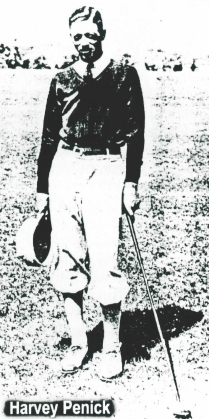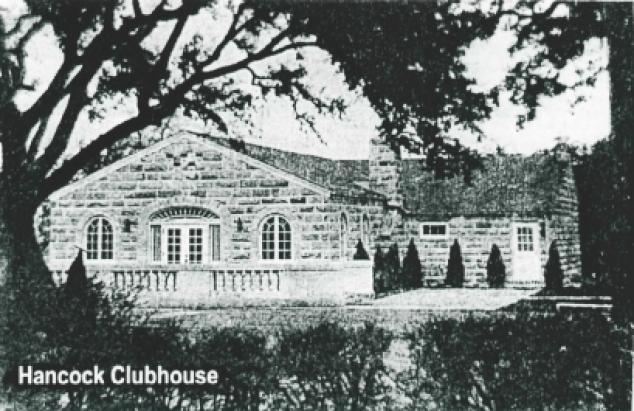A Brief History of Hancock Golf Course: The First Hundred Years
By John W. Ramzy, Ph.D.
Lewis Hancock, our neighborhood Founding father, visionary, and a mayor of Austin, organized a meeting of close friends at the Driskill Hotel in 1899 for the purposes of organizing a golf club. Hancock had become interested in golf through his travels including trips to Scotland. He was elected President of the club unanimously by this group of citizens that included Professor David Houston, Will Bell, Drs. Clever, Jack Phillips, and T. W. Gregory. (1) This organizational committee filed Articles of Incorporation on January 10, 1900 with Messieurs Hancock, Houston, Gregory, David Harrell, and R. H. Connerly as the five original directors. Golf has been played longer at this location than anywhere else in Texas.
The members sought out to find acceptable locations for the nine-hole gall club Several locations were considered, and the most popular among the directors was the strip of land fronting on Groome Street, today known as Duval. This land was leased to the club. The small nine-hole course was constructed with sand greens. Lewis Hancock has been known to have personally scraped fairways with farm implements. This land was later abandoned for land east of Waller Creek, and later the land west of the creek as we know Hancock Golf Course today.
The first central gathering point for the newly formed golf club was a large mesquite tree on the hill overlooking Waller Creek. This tree as stall very visible today, and can be found along the current boundary along Peck Avenue. Shortly thereafter, in 1900, a small shack was built for $100 to serve as the clubhouse. A fire, a frequent occurrence at the golf clubhouses, later damaged it.
In June of 1901 the members celebrated the dedication of the first real clubhouse which was a two-room, wood-framed building which today can be found as a remodeled residence at 512 E. 39th Street. In 1908 a new, much larger, two-story, red clubhouse was built at the current location of the Hancock Recreation Center and Golf Shop.
In 1914, after fire damaged the building, it was reconstructed and enlarged to accommodate the growing membership. At this time there were approximately 300 members. This stucco clubhouse was painted white and green and again destroyed by fire on March 14, 1934 after a Saturday night dance, and at a time when the insurance coverage of the clubhouse was found to be well under the replacement value of the improvements. Yet the resourceful members again remodeled the structure that same year. At the same time, the University of Texas was tearing down Old Main and the membership arranged for use of some of the materials being torn down. The membership elected to acquire the brick and stone and reuse the materials for the new clubhouse, which was adorned with stucco as well.
In 1963 fire struck again and damaged a portion of the by-then city-owned clubhouse. At this time under city ownership, the building was repaired with a major alteration transforming the kitchen into a classroom.
Julia Pease, daughter of Governor Pease, was one of Austin's first lady golfers. Proper attire for lady golfers during the era was long skirt.
Betsy Rawls played at Hancock and Hilda Urbantke was a top amateur player out of Hancock. Other players at Hancock included Martha Westmorland, Patty Berg, and Louise Suggs. Hancock attracted top players, many coming for exhibitions
Notable members of the early Country Club days at Hancock included T. W. Gregory who was, along with being an original member of the club, served as Attorney General of the United States under President Woodrow Wilson; Dr. David F. Houston who was former Secretary of Agriculture, Secretary of the Treasury, and later President of the University of Texas; Lyndon B. Johnson who served as U.S. Representative, U. S. Senator, U. S. Vice-President, and U.S. President; John Connally who served as Governor of Texas, as Secretary of the Navy, and as Secretary of the Treasury; and J. J. Pickle as U.S. Representative.
Local talent playing out of Hancock included amateurs Tom Miller Jr., Jimmy Connolly, Buck Luce, and Morris Williams, Jr.
A famous gambler paid two visits to the club. He was Titanic Thompson, of whom there are books and articles written. He was a hustler and known for his feats on and off the golf course. Once he bet the members he could throw a peanut over the clubhouse, and did!
Another time in the late 1930s a financial disaster struck. The Texas Rangers raided the club removing three illegal slot machines, and taking sledgehammers to them in the club parking lot.
The first documented competitive golf contest was February 21, 1900, with Mr. Walter Bremond winning the handicap tournament and scoring a net 73 score for two rounds over the layout. Mr. Hancock presented the winning medal to Mr. Bremond. (2)
The first club professorial was Bull MacKenzie, followed by George Dow, Carl Baker, Jim Smith, and 18-year-old former caddie Harvey Penick who began has professorial career at Hancock/ Austin Golf Club in 1923. The club directors held the vacant position open for Harvey for one month so he could finish his final year of high school.

As the club grew, the membership elected to accommodate an expansion to an 18-hole golf club. Edgar H Perry, the club's second president, led efforts to acquire the 40-acre Ernst Farm. This land was acquired on February 18, 1913 (3) and is the current location of the Hancock Shopping Center. The purchase price of the land was about $400 per acre.
The course architect according to golf course researcher Frances G Trimble, was John Bredemus, the same architect who designed Colonial Country Club in Fort Worth. The 18-hole course had a par 36 front and par 36 back nine. The back nine had very few trees with fairways shaped among mounds, high rough, and bunkers similar to the Scottish style links courses. There was no driving range at Hancock.
The 12th holes was a par three with players teeing off from just east of Red River Street, attempting to negotiate the flight of the ball over the street, onto the 12th green which today is located in the depression at the northeast corner of the existing course.
Members received much criticism for golf balls flying over the street and eventually had to shorten the 150 yard hole to about 70 yards and eliminate the over-the-avenue flight of golf balls.
In 1946, the Austin Country Club was interested in selling the entire property consisting of 93 acres and relocating outside the city limits. Mayor Tom Miller was in support of the city purchasing the property to add to the recreational properties for the citizens of Austin. A large public hearing was hold in September of 1946 and mixed response wars hoard from the citizens regarding support for the city purchase. After many formalities, the city ultimately accepted the country club's below-market value offer to sell the land to the city for $175,000. The transaction closed in December of 1946, with the final deed recorded January 3, 1947.
The City of Austin became the owner of Hancock Golf Course in its entirety. The Country Club remained in operation under city ownership for three years while the Riverside location was being completed for relocation. In January of 1951, the Country Club officially gave the city operation of the golf club grounds and clubhouse.
Dedication of the property as a park was not so certain. Already in the minds of Austin's leading citizens was the intention to dispose of the Hancock east 40 acres to finance other recreational developments for the City of Austin. A motion for the City Council to dedicate the entire property as a park failed 3-2. A motion to dedicate the 50 acres lying west of Red River passed unanimously. This action left the back nine vulnerable to disposition by the city leaders. Almost immediately a movement developed to sell the back nine property.
In September 1954, the city had interest from private parties to sell the back nine property. Several offers were received. On December 8, 1959, the city agreed to sell the Hancock East 40 to Homart Development for $800,000 and a deed was filed for the sale on December 8, 1959. (4)
Shortly alter the sale, litigation was filed by interested taxpayers. The suit ultimately went to trial with Judge Herman Jones presiding. The decision was that the back nine had been dedicated as a park, and the city council overstepped their jurisdiction by selling the land. He ruled that since the land had been used consistently as a public park, the sale was subject to a public vote. Later a referendum was held on February 10, 1962 for the citizens to decide the fate of the back nine. Many citizens favored the sale since the city had proposed a five-year capital improvement program to parks and playgrounds on city recreational properties. Funding from the $800,000 proposed sale would be used to fund these improvements.
The election was a hotly contested one with major campaigning by both sides. No title insurance had been issued to Homart, so the sale was not complete. Among those city leaders who were pro-sale included Edgar Perry as Mayor Pro-Tem, Mayor Lester Palmer, Hub Bechtol, Ed St. John, Louis Shanks, and Ben White, the latter two of whom were Councilmen at the time. The voters approved the sale and construction on the Hancock Center began in 1964. (5)
In 1980, due to operating deficits at the city owned golf course, the Parks and Recreation Department proposed closing the golf operation at Hancock. The annual deficit of $30,000 gave rise to the notion that the city would close the golf course and turn the open space into softball, soccer fields, and open space. An opposition charge by the newly formed Hancock Neighborhood Association kept the course operation alive. Hyde Park and Red River neighborhood associations joined in the opposition. The City of Austin today operates the nine hole public course and the clubhouse is used primarily as a recreation center. Steve Darby is the club professional. Numerous groups meet regularly at the recreation center. A major focus is children's programs such as introduction to golf workshops and a number of ongoing sports activities. No apparent attempt is underway to close the golf course and for that we are grateful.

Notes:
(1) Austin Daily Statesman, November 14, 1899, with compliments of Ham-Mer Consulting Engineers, Inc. as noted in The Women's Texas Golf Association
53rd Annual Tournament booklet of the Country Club of Austin, 1974, p.43.
(2) Austin Daily Statesman, February 22, 1900 with compliments of Stripling Blake Lumber Co., Inc. ibid., p.47.
(3) Elane Taylor Brown, "Hancock Recreation Center, an Historic Preservation Documentation AMC 389," for Dr. Wayne Bell research paper, University of Texas, May 10, 1984.
(4) Ibid.
(5) Sam Griswold, "Hancock East 40 - From Country Club to Shopping Mall," The Maplewood Messenger, A Free Community Newspaper, March, 1982.